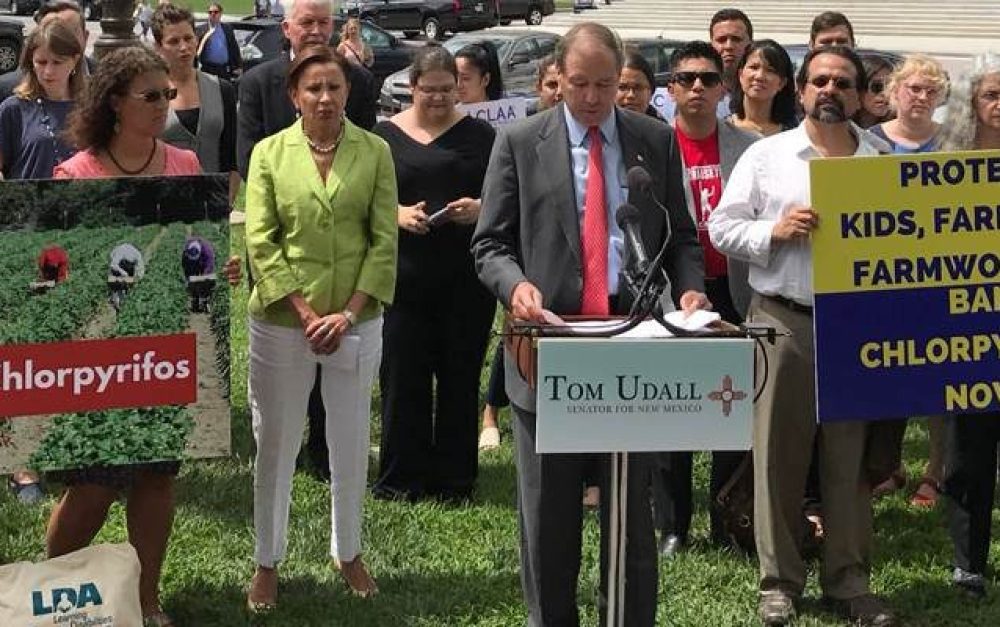Chlorpyrifos is linked to long-term damage in children’s developing brains
For Immediate Release—July 25, 2017
Washington, DC – Today, Senators Tom Udall (D-NM), Kirsten Gillibrand (D-NY), Cory Booker (D-NJ), Richard Blumenthal (D-CT), Kamala Harris (D-CA) and Edward J. Markey (D-MA) unveiled a first-of-its-kind bill that would ban chlorpyrifos, a widely used agricultural pesticide that has been linked to reduced IQ and attention deficit disorder in children. Chlorpyrifos, an organophosphate that comes from the same chemical family as sarin nerve gas, is used in the growing of staple foods like strawberries, apples, citrus, broccoli, and more.
The Protect Children, Farmers & Farmworkers from Nerve Agent Pesticides Act amends the U.S. Federal Food, Drug, and Cosmetic Act that oversees food safety and prohibits all chlorpyrifos use. It also directs the Environmental Protection Agency (EPA) to partner with the National Research Council to assess the neurodevelopmental effects and other low-dose effects that exposure to organophosphate pesticides has on agricultural workers and children. Representatives Nydia Velazquez (D-NY) and Keith Ellison (D-MN) introduced a companion bill in the U.S. House.
“We applaud these Senators for taking a stand for rural families and children across the country,” says Kristin Schafer, Executive Director of Pesticide Action Network (PAN), one of the organizations on the original legal action petitioning EPA to ban chlorpyrifos. “The science is clear that this brain-harming pesticide is unsafe to use in any amount. Secretary Pruitt’s anti-science decision cannot stand.”
The bill was unveiled in the presence of more than thirty representatives from health, labor and civil rights organizations from across the country. The delegation met with senators to seek their leadership in banning chlorpyrifos. The coalition is urging officials to support the bill and protect the health of the millions of workers and children who are exposed to chlorpyrifos every year.
“By leaving this chemical on the market we are gambling with the lives of children,” says Bonnie Wirtz, a former Minnesota farmer whose family suffered health effects of chlorpyrifos drift. “It is stealing their futures from them and increasing the amount of health care dollars they will need for treatment.” Bonnie’s son was exposed to chlorpyrifos at 14 months, and has since been diagnosed with a neurodevelopmental disorder.
“No family should be facing a life of special needs because of chlorpyrifos,” said the delegation in a joint statement. “If the EPA refuses to protect the health of our children and agricultural workers, then lawmakers from both sides of the aisle must do their jobs and back the chlorpyrifos ban bill. The health of our communities depends on it.”
The bill comes days after a court of appeals declined to direct EPA to act on whether to ban the controversial pesticide. Chlorpyrifos is linked to long-term damage to children’s developing brains and nervous systems even at low levels of exposure during pregnancy and early childhood. It is also acutely toxic.
In March, EPA refused to ban chlorpyrifos claiming the science is “unresolved” and decided it would study the issue until 2022. That decision came weeks after agency Administrator Scott Pruitt met with the head of Dow Chemical, which sells chlorpyrifos under the name of Lorsban. In refusing a ban, EPA reversed its own proposal to ban all food crop uses of chlorpyrifos.
Groups have appealed the EPA decision directly with the agency. Attorneys general from various states have also called for a ban in their own appeals.
Chlorpyrifos was banned from residential use 17 years ago as it was considered too toxic. But the use of the same pesticide on the country’s food continues even though the 1996 Food Quality Protection Act requires EPA to protect children from unsafe exposures to pesticides.
Though all families across the country are in danger, rural communities face a disproportionate exposure to the pesticide.
Contact: Paul Towers, 916-216-1082 or ptowers@panna.org
###
Photo: EarthJustice







